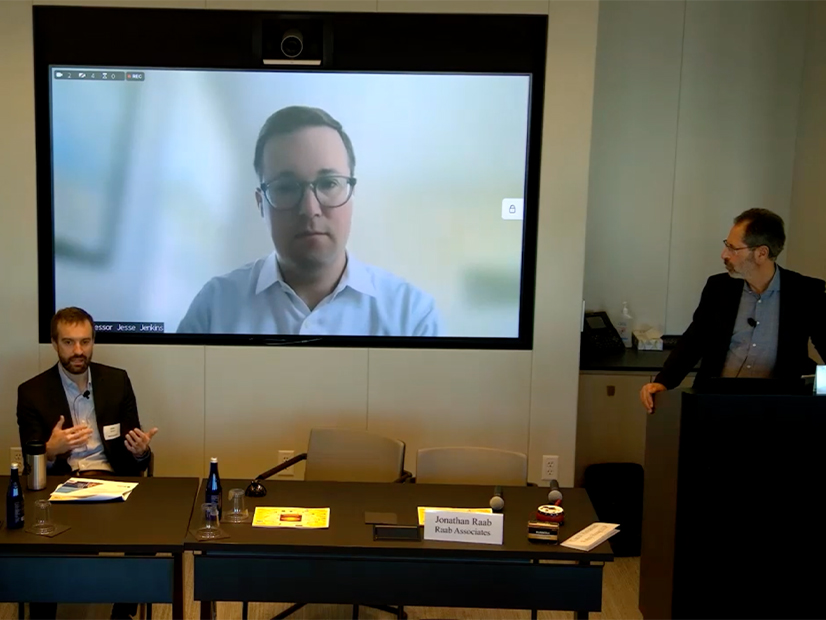
A parade of experts extolled the virtues of more granular clean energy purchasing at Raab Associates’ New England Electricity Restructuring Roundtable earlier this month, calling it essential to meeting climate goals in the region and around the country.
Citing the limitations of the widespread annual matching that makes up most corporate and institutional clean energy procurement, the academics and policymakers also called for grid operators to develop data to help lead the charge.
“In order to fully decarbonize our electric grid in New England, we will very likely need to realign our policies, procurements and supporting data from its current broad-brushed monthly and annual matching frameworks to ones that focus either on a much shorter period time, such as hourly, or on marginal emissions rates, or both, as well as more granular locational matching,” said Jonathan Raab, convener and one of the moderators at the event Dec. 9.
Jesse Jenkins, a Princeton University professor and prominent energy expert, laid out the problem: While voluntary clean energy procurement through long-term contracts has helped finance renewable projects, it has significant limitations that are becoming more clear.
“There are times when the production from wind and solar is quite a bit lower than the consumption from the procuring consumers,” Jenkins said. It’s a mismatch that “limits the ability to reduce CO2 emissions associated with the buyer’s consumption.”
A solution that’s coming to the fore, led by some major corporate buyers, is 24/7 matching, where companies try to purchase clean energy that matches their demand hour by hour, from within the same region.
“I think 15, 20 years ago, probably the best we could have done was annual matching. It made sense to make an assumption that all clear resources are equal,” said Kathleen Spees, a principle at the Brattle Group. “It’s certainly not always true now.”
Hour-by-hour carbon-free procurement enables “deeper emissions reductions than annual matching,” Jenkins said.
And it drives early deployment of advanced technologies, helping to create “niche markets” that can help pull forward technology like clean firm generation and long-duration storage.
But there’s a key reason why more companies aren’t doing this yet: It’s expensive.
“There is a cost premium for first movers who want to go from annual matching all the way up to 100%, or near 100% hourly,” said Mark Dyson, managing director for carbon-free electricity (CFE) at RMI.
Dyson worked on a project with Microsoft last year to assess the costs, emissions impacts and system transformation impacts of procuring CFE on an hourly basis to match their load.
It’s the tech giants that have been the earliest movers in the space. Along with Microsoft’s work, Google is one of the first companies to start diving deep into 24/7 matching.
At the second panel of the day, moderated by Janet Gail Besser, vice president of the Smart Electric Power Alliance, Google’s head of energy market development and policy, Caroline Golin, laid out the company’s plans.
“Our goal is that every hour of every day, all of our facilities will match our energy use with carbon-free energy, and that all of that energy will be procured locally within the balancing authority or RTO in which we operate,” Golin said.
It’s an evolution of the company’s goal to use 100% renewable energy to power its operations.
“Google’s a large company that has invested a lot of internal resources and deployment of capital to meeting our clean energy goals. We recognize that we’re a unique player in the field,” Golin said.
It’s also trying to help other companies learn from its experience, sharing information about its business model.
“The leadership that we’re seeing from corporate buyers is really exciting,” said Spees, who noted that they don’t have the same constraints as public entities. “They can just sign a contract around a corporate objective they believe in.”
A Data Problem
Another challenge with more granular matching is that it requires a heavier lift with data, both for companies looking at their consumption and for grid operators or other entities measuring emissions.
“There is no market structure to date that is built for a completely decarbonized electricity system,” noted Golin.
Misti Groves, vice president of the Clean Energy Buyers Association, said that her members need more to go on.
“To do more, customers need accessibility, transparency and a standardized format,” she said, adding that a centralized database would be ideal.
“Right now, companies are using inferior datasets that are not reconciled,” she said.
A number of corporations can’t accurately measure their consumptions, she said.
“You’d think a fundamental question is, what’s your load? What’s your consumption?” Groves said. “A baseline is incredibly important.”
Tanuj Deora, director of clean energy at the White House Council on Environmental Quality, laid out the framework, in the form of an executive order, that the Biden administration has set to increase the government’s procurement of carbon free electricity.
“We wanted to have a strategic shift, recognizing that we are the largest buyer in the country and therefore have a lot of influence with suppliers,” he said.
Geography matters, Deora added.
“We focused on the idea that high levels of CFE are possible, and that there are going to be different pathways, balancing area by balancing area,” Deora said.

